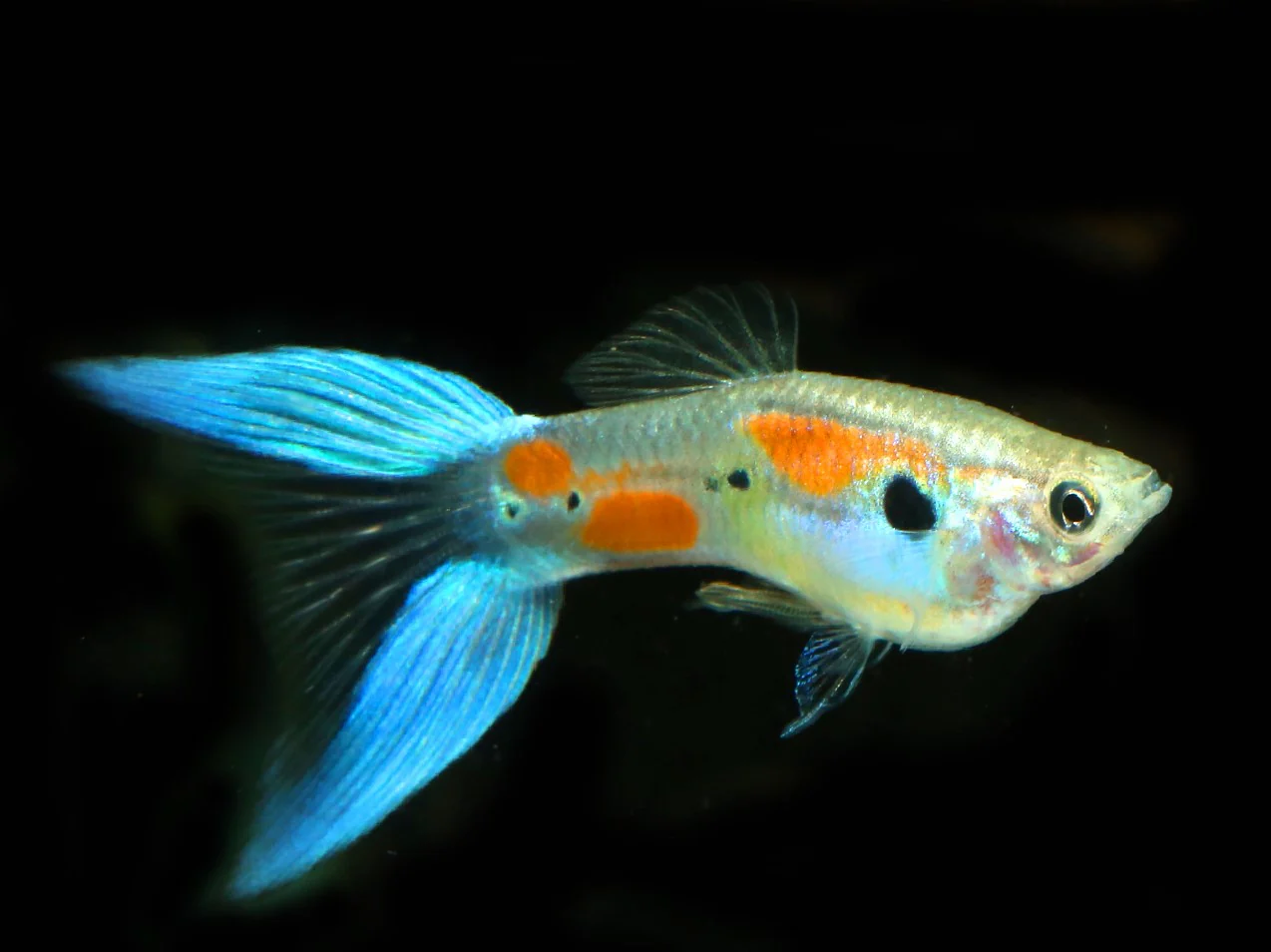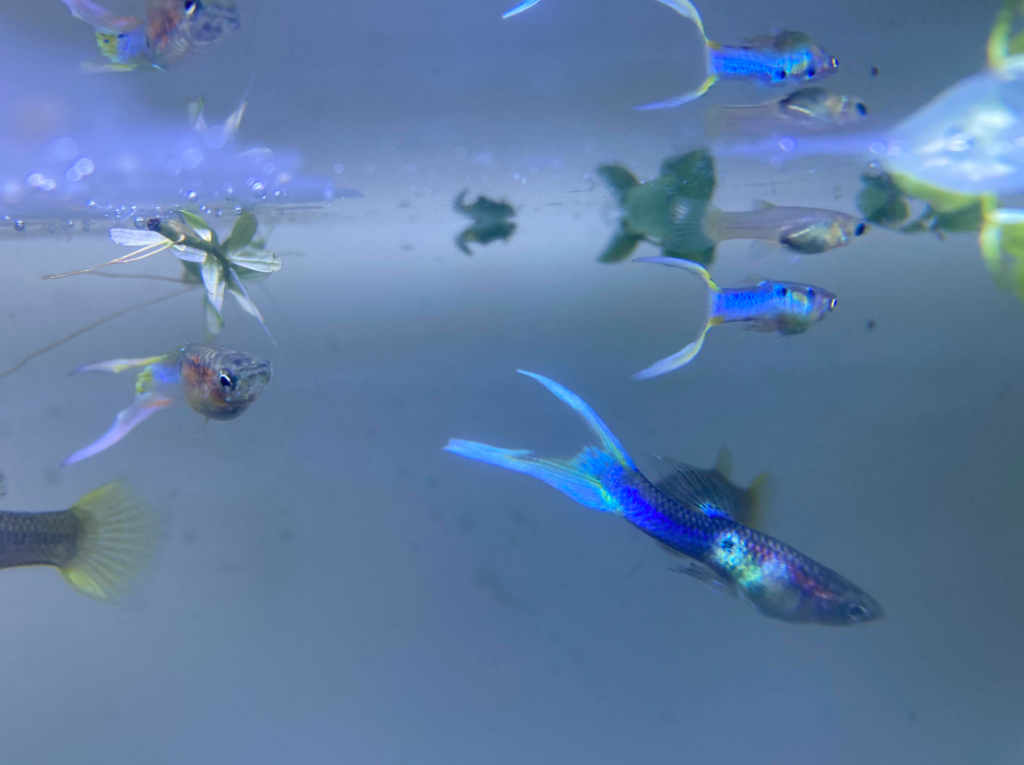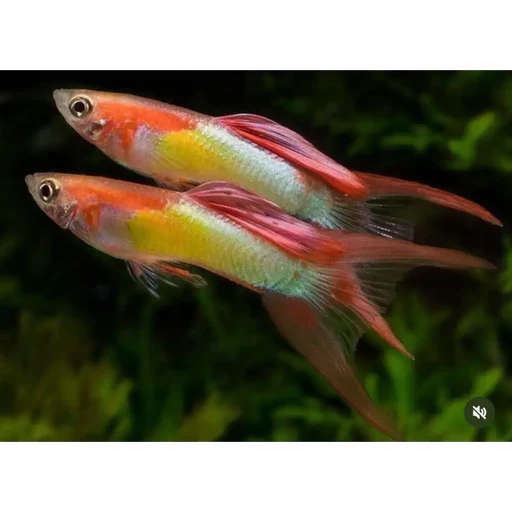Maintain the subtle elegance of the Lyretail guppy fish with these simple care routines. In this comprehensive post we share everything from identification and tank setup to feeding, breeding, and much more to get you started with the Lyretail Guppy!

The Elegant Lyretail Guppy
Welcome back to another broad review of a low-maintenance yet highly rewarding aquarium pet, the Lyretail Guppy fish. In this Lyretail Guppy overview, I’ll show you the ways you can identify this fish, specialized care requirements for optimal health and tips for breeding more of this elegant guppy fish.
This species is renowned for its distinctive lyre-shaped tail and dazzling colors, which are two of its most defining features.
These striking aquarium guppies are sensitive because of their physical characteristics and that’s why they have distinctive care requirements. If you want to know how to care for this unique guppy variety you’re in the right place. So sit back and enjoy your next few minutes of knowledge.
Quick Sidenote: Do you want to watch this article instead of reading it? Checkout the highlight video below from our YouTube Channel (Or read the more detailed article below), be sure to Subscribe For More Great Fishkeeping Content:
Distinctive Physical Characteristics of Lyretail Guppies

The Lyretail Guppy’s appearance stands out in the aquarium world because of its tail, size and scale colors.
The Lyre-Tail
Its most distinctive feature is the iconic lyre-shaped tail, which resembles a symmetrical fork with long, pointed extensions on both sides.
The Lyretail is smaller than other guppies, not growing even up to a max of 2 inches, tail included.
Bright Coloration
However, it also has vibrant, guppy colors that shimmer in the light and highlight the lace-like fins on its slender body.
So, even though it doesn’t have the flowing fins of other popular guppies which would also give them a unique swirl as they swim in the water, its stunning coloration makes up for it. You can still make the Lyretail Guppy a centerpiece in your aquarium, given the right environment.
Essential Care Requirements for Lyretail Guppies
To keep Lyretail Guppies healthy and vibrant, maintaining proper guppy health and wellness should be your priority. Provide a well-maintained aquarium with optimal water parameters, interactive decor, compatible tank mates, and other guppy care essentials detailed below.
Here’s a summary of how to achieve that:
Essential Water Parameters
Maintain a temperature range of 72-82°F, pH 6.8-8.5, and hardness 5-20 dGH. These parameters create the optimal freshwater aquarium for your Lyretail guppy’s survival.
Tank Maintenance
Change about 25-50% of the tank’s water weekly to maintain stability crucial for preserving the guppies’ stunning tail structure.
You may wonder how this works, so I’ll explain it.
When you don’t change your tank water often, you risk bacteria and fungus build-up from leftover food and active live plants interacting with light in the aquarium. These growths contaminate the water and become harmful to your Lyretail guppy’s health.
Physically, they may get parasitic infections that mess with their coloration, while internally, they could have bacteria that stunt their growth.
We recommend using a master test kit like the one form amazon linked below to frequently test your water parameters.
Filtration
Use a sponge or hang-on-back filter to clean the water with a gentle flow because a large canister filter may suck your Lyretail guppy in with its current.
More Care Tips
Feed a balanced diet with varied nutrients, and avoid overcrowding the tank to prevent stress. There’ll be more on this soon, but first, follow this Lyretail guppy care guide recommendations to create a thriving environment for your pets.
Creating the Perfect Tank Environment for Lyretail Guppies

To create the ideal aquarium for guppies, pay attention to the water parameters already provided in this article, and then build the perfect environment for your pets using their natural habitat as an inspiration.
This Lyretail Guppy tank setup will reduce stress, encourage active swimming, and showcase their vibrant colors.
Tank Size
Because the Lyretail guppy is a small fish, you don’t need a large tank to house a single one. You can get a 10-gallon rectangular tank for one Lyretail guppy. It has enough room for swimming amongst decor and substrates.
Decorations
Incorporating live plants like Java Moss and Hornwort, which provide hiding places and visual interest, is ideal for enhancing fish habitat.
Create the perfect tank environment for your Lyretail guppy by combining plants with open swimming spaces, rock caves, and other decorative pieces like driftwood and stones.
Don’t get carried away with designing and forget to prioritise your pet’s well-being and health. Strike a balance between implementing useful plants and aquarium décor.
Feeding and Nutrition for Lyretail Guppies
A proper Lyretail Guppy diet filled with protein, fiber, carbs, and veggies is perfect for the health, growth, and vibrancy of the guppy fish’s coloration.
Provide your Lyretail guppy with a balanced diet that includes high-quality flakes, pellets, and live or frozen foods as the staples.
Choose products rich in carotenoids, such as spirulina and fresh vegetable-based foods, as supplements because they’re good for enhancing fish color through diet.
Optimal feeding practices for guppies should emphasize variety. So also add brine shrimp, daphnia, and bloodworms to the diet. If you want food for healthy tails, give your Lyretail guppy vitamins and Omega-3 fatty acids.
For more on feeding your aquatic pets check out The Ultimate Guide to Fish Food: Pros and Cons & Best Choices!
Feeding Regimen
Feed adult guppies twice daily in small portions that are consumable in a few minutes. This prevents overfeeding and maintains water quality.
You’ll have to modify your feeding regimen and diet for young guppy fry because they have other nutritional needs. Use this young fry guppy nutrition guide to get the best result:
- Feed them finely crushed food until it’s powdered.
- Add specialized fry formulas as foods of choice to support their rapid growth.
- Feed them three to four times daily but also in small portions.
Health Concerns and Disease Prevention

Lyretail Guppies are generally hardy fish, but their long tails make them prone to specific health concerns. This Lyretail Guppy health guide touches on common concerns such as fin damage and diseases that particularly affect their long tails.
Fin Rot
- Cause: Fin rot is a bacterial infection causing frayed or torn fins.
- Prevention: maintain clean water, avoid overcrowding, and provide adequate hiding places.
- Early signs: frayed fin edges and discoloration.
- Treatment: antibiotics, improved water quality.
Tail Biting
- Cause: Tail biting is a behavioral issue where tankmates nip at the Lyretail’s long tail.
- Prevention: Separate aggressive fish and provide plenty of hiding places.
- Early signs: torn or frayed tail tips.
- Treatment: Separate affected fish and improve tank dynamics.
Gill Disease
- Cause: bacterial or parasitic infection affecting respiratory health.
- Prevention: maintain optimal water parameters and avoid overcrowding.
- Early signs: labored breathing, lethargy.
- Treatment: antibiotics, water changes.
Ich
- Cause: parasitic infection causing white spots on the body and fins.
- Prevention: quarantine new fish to maintain clean water.
- Early signs: white spots, scratching.
- Treatment: medicated treatments, water changes.
For more details checkout our article on How to Treat Ich Outbreaks in Your Freshwater Fish!
General Health Care and Prevention Tips
Caring for delicate fishtails requires gentle handling during maintenance and avoiding aggressive species in community tanks.
Regular water changes, a balanced diet, and maintaining harmonious tank dynamics are easy disease prevention tips you should remember to keep Guppies healthy and thriving.
Additionally, stress can lead to health problems, so keep stable water parameters with a consistent feeding schedule to give your pets a healthy routine. Guppy health management requires regular monitoring and prompt action at the first signs of distress.
If you’ve mastered the care requirements for this species and want to breed more of them, here’s what to do.
Breeding Lyretail Guppies: Key Insights

Breeding Lyretail Guppies requires careful selection and providing optimal conditions to ensure the preservation of the unique traits. Follow the breeding and guppy fry care tips provided to achieve your goal!
Choosing the Breeding Pair
Be mindful when selecting breeding pairs. Ensure you choose healthy, vibrant fish with pronounced lyre-shaped tails from different lineages to prevent inbreeding and promote genetic diversity.
This video has been very helpful in identifying the sex of Guppies, I highly recommend it:
Breeding Tank and Behavior
Provide hiding spots with plants or decorations to reduce stress during breeding. Introduce the male to the female in a separate breeding tank and observe closely for courtship behaviors.
Feeding the Fry
Upon the birth of the guppies, provide finely crushed flakes or specialized fry food for guppy fry, ensuring they receive adequate nutrition for healthy growth. Maintain clean water and perform regular water changes.
Remember, preserving lyre-shaped tails boils down to your ability to breed fry that exhibit this characteristic and cull any that do not meet your standards.

Lyretail Guppy’s behavior is active, curious, and friendly, which makes it a perfect species for a community tank. This fish thrives in groups, displaying interesting guppy social dynamics, especially with schooling and courtship.
When considering compatible fish species, choose small, non-aggressive fish such as neon tetras, rasboras, and Corydoras catfish. Avoid larger or aggressive species.

Having a well-spaced tank with enough hiding spots will reduce territorial disputes. Perform regular water changes and maintain stable water parameters so all the species can live in harmony. As little a task as water changes may seem, it plays a large role in ensuring the well-being, wellbeing especially emotionally and mentally, of your Lyretail guppy with its companions.
Here are more species you may add to the tank if you care about maintaining peaceful aquariums:
- Apple Snails
- Common Molly
- Bristlenose Pleco
Conclusion
This Lyretail Guppy care overview introduced you to how easy it is to maintain this variety, which makes them perfect for beginners and seasoned aquarists.
You also know now that its ornamental beauty is not its only defining feature. It’s also a lovable species that lives well with other compatible water dwellers.
The highlights of this aquarium fish care guide for Lyretail guppies include
- maintaining stable water conditions.
- providing a well-planted environment and,
- feeding high-quality flakes or pellets.
Adding vibrant guppies to your tank not only enhances its aesthetic appeal but also brings joy through their lively behavior and social interactions.




